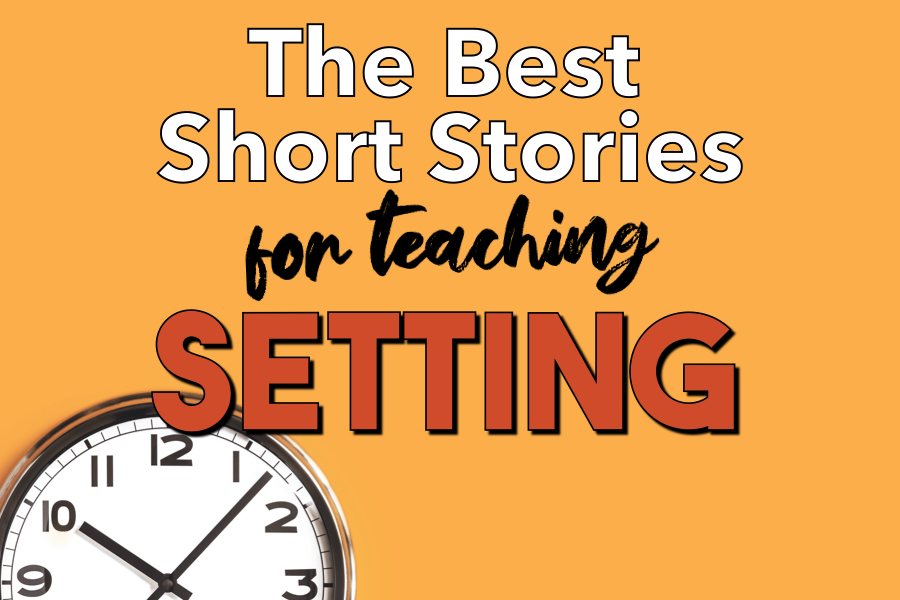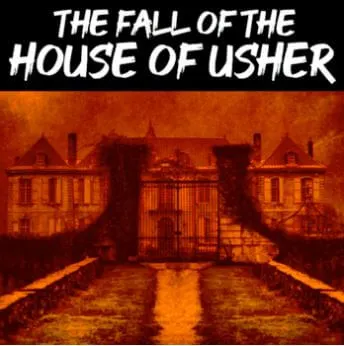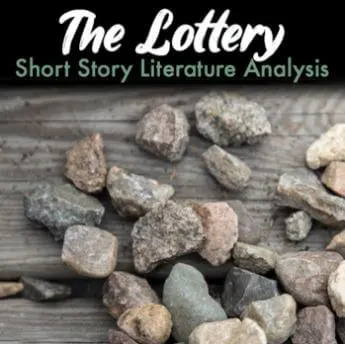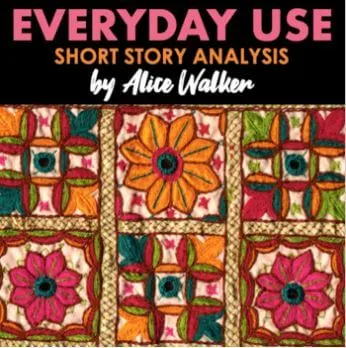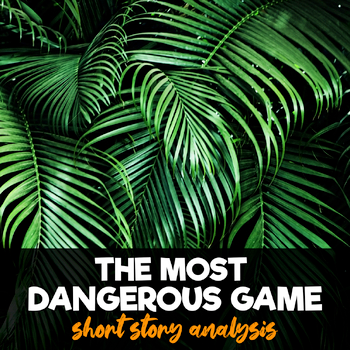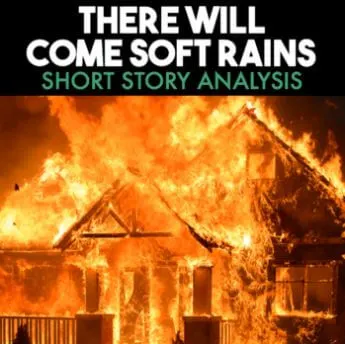Teaching setting is a vital aspect of literary analysis in the secondary classroom. However, it’s imperative to go beyond a surface-level definition. Read on to learn the titles of best short stories for teaching setting and tips for helping students analyze this essential literary element.
Let’s just cut to the chase–teaching setting is a critical component of literary analysis. Students are sure to have a basic understanding of what setting is in a story. However, while many students recognize setting as when and where a story takes place, we must guide them to understand that setting can be so much more than just time and place. Therefore, explicitly teaching setting and guiding students to understand how to recognize, unpack, and analyze a story’s setting is a must.
The Importance of Teaching Setting
Can you imagine reading Harry Potter without the wizarding world of Hogwarts? Of course not! That’s because the setting of Hogwarts helps bring the magical story to life. But it’s not just fantasy worlds that hold a lot of power and meaning. Think about how much the Salem village of The Crucible or the German town and World War II in The Book Thief help the stories unfold.
You get the point, right?
Setting is so much more than *just* the backdrop of the story. In some cases, the setting is just as prominent to the plot and development as, say, the main character. Settings help deepen a story’s meaning and impact by working with other literary elements such as character, theme, and mood to bring a story to life.
In other words, if we neglect to teach setting, we’re leaving a lot on the table.
Using Short Stories for Teaching Setting
As with teaching other literary elements, short stories are a great stepping stone in student learning. Now, stepping stone does not mean simple. Some of the stories mentioned below are rich and challenging texts. However, due to their shorter length, they are much more manageable for students than an equally dense novel spanning hundreds of pages.
One of the reasons I love using short stories for teaching setting is that you can expose students to a variety of settings without taking up a ton of time. Additionally, students can track a changing setting and its implications on the plot and characters without getting confused. You can also assign reading a short story for homework before conducting close readings and discussions in class. I mean, these are just a few of the reasons why short stories are the perfect teaching tool when diving into literary elements, like setting.
The Best Short Stories for Teaching Setting
If you’re trying to showcase the depth and implications of a setting, choosing the right short story is a must. The titles below have strong settings that reveal much more about the story than when and where.
1. “The Fall of the House of Usher” by Edgar Allen Poe
Poe is the master of a spooky vibe. However, it’s about more than creating that eerie gothic setting he’s so well known for. While many of his well-known short stories would work here, “the Fall of the House of Usher” is a go-to, showcasing his ability to create a strong mood through a dismal setting. From the “white trunks of decayed trees” to the “vacant, eyelike windows,” Poe describes the titular house of Usher in a way that will have hairs on the back of your neck standing up.
But it’s about more than that haunted house feel. The setting in this story both reflects the twisted Usher family, hints at Roderick Usher’s declining physical and mental state, and foreshadows the home (and family’s) ultimate demise.
2. “The Lottery” by Shirley Jackson
While not a gothic piece of literature, Jackson’s “The Lottery” is eerie all the same. However, unlike Poe, Jackson sets her horror story against a rather picturesque backdrop. Of course, she does this with full intention, setting the reader up for a shock as the story unfolds. Students love discussing how the quaint small town setting emphasizes the horror of the town’s annual lottery and the townspeople’s mindless willingness to participate in the murderous tradition. By the end, students will be eager to go back and analyze the setting for clues that foreshadowed the story’s gruesome ending.
Furthermore, it’s fun to point out that Jackson’s story takes place in an unnamed town. While students are quick to overlook this detail at first, it’s worth circling back to. Ask students why Jackson chose to set her story among the blooming flowers and green grass of an unnamed small town.
3. “The Veldt” by Ray Bradbury
Let’s stick with horrific endings, shall we? Much like “the Lottery,”, the horror of Bradbury’s “The Veldt” isn’t realized right away. Instead, Bradbury begins his story in a futuristic setting of the “Happylife Home,” a fully automated house. Though, if you ask me, there is something a little eerie about that. In fact, it’s the way that George Hadley, the father, begins to question the impact of the tech-dependent home that first cues the creepy vibes to come.
But the real horror doesn’t come until Bradbury introduces the setting of the nursery, where the Hadley children spent much of their time. As students read, there’s a lot to discuss regarding how the setting influences the characters (and vice versa), ultimately leading to the gruesome death of the parents, George and Lydia.
4. “Everyday Use” by Alice Walker
Walker crafts a powerful narrative in her short story, “Everyday Use.” Part of what makes it so powerful is, to no surprise, the beautifully detailed setting. Mama, the story’s narrator, begins by describing her family home in great detail as she prepares for her daughter’s visit. However, it’s how each character reacts to the setting that really drives the story, giving students plenty to discuss post-reading.
It’s not only the house that carries a big meaning. The story’s historical and cultural setting of the rural south during the 1960s plays a big role in unpacking the story’s deeper meaning and social commentary regarding race and heritage.
5. “Winter Dreams” by F. Scott Fitzgerald
Much like his acclaimed novel, The Great Gatsby, Fitzgerald creates a sense of illusion and allure through the setting of his short story “Winter Dreams.” Dexter, the narrator and protagonist, gives great and glamorous details about the story’s main setting, the Sherry Island Golf Club, where he first becomes enamored with Judy Jones. Not only do these details paint a picture of the story’s backdrop, but they also paint a picture of desire.
As students read, challenge them to track how this rich setting (literally) becomes the backbone for Dexter’s “winter dreams” and his desire for all of the glitz and glam that Judy represents. Furthermore, the setting reflects the illusion of the American dream, emphasizing Fitzgerlad’s commentary on the materialism and consumer culture of the time. While this story is much longer than others on the list, it’s certainly worth it if you have the time to weave it into your curriculum.
6. Anything from Sherwood Anderson’s Winesburg, Ohio
Similar to Shirley Jackson’s “The Lottery,” the stories of Winesburg, Ohio are set in a rather simple small town. But that’s pretty much where the similarities end. (No stone throwing here.) Anderson uses the setting of the fictional small town of Winesburg to showcase the complexities hidden within a simple setting. While the town is cute, simple, and quaint from a distance, the characters are far more complex. Therefore, Anderson emphasizes the themes of tradition, isolation, independence, and personal discovery.
The setting of the stories in this collection give off a nostalgic vibe, creating a sense of unity and common understanding between the characters and the reader. However, it also stirs up the question of personal desires and how where we come from plays a role in who we are and what we long for.
7. “The Yellow Wallpaper” by Charlotte Perkins Gilman
Students are sure to have a lot to say after reading this short story–particularly about the role of the story’s setting on the narrator. While students are quick to catch on to the narrator’s declining mental state, it’s much clearer with the help of the story’s main setting–a room with yellow wallpaper. Sure, it might not sound like much at first, but the deeper you get into the story, you begin to realize the wallpaper is much more than a bright wall covering. In fact, it’s the driving force and main indicator of the woman slowly losing her grip on reality as she slips into insanity.
However, the yellow wallpaper isn’t the only setting students can discuss. There are plenty of opportunities to dig into the description of the large, yet isolated summer house in which the yellow room lives. Coincidence? I think not. It’s also worth noting the historical implications as the story was truly groundbreaking at the time, drawing attention to the author’s strong social commentary regarding mental illness and gender roles in the late nineteenth century.
More Great Short Story Titles For Teaching Setting
There are many great short stories with strong settings circulating out there. The list above is far from exhaustive. Here are a few other titles that make for a great teaching tool when it comes to setting.
8. “The Most Dangerous Game” by Richard Connell
9. “So What Are You Anyway” by Lawrence Hill
10. “The Monkey’s Paw” by W.W. Jacobs
11. “A Rose for Emily” by William Faulkner
12. “The Minister’s Black Veil” by Nathaniel Hawthorne
13. “The Devil and Tom Walker” by Washington Irving
14. “To Build a Fire” by Jack London
15. “The Cask of Amontillado” by Edgar Allen Poe
16. “There Will Come Soft Rains” by Ray Bradbury
Discussion Questions for Teaching Setting
It’s imperative that we guide students through the discovery of just how impactful a setting is for a literary work. The following questions are a great starting point for helping students analyze a setting on a deeper level.
These questions make for a great post-reading discussion. However, you can also provide them to students as a way to more formally assess their understanding and application of the literary element through writing. Either way, these questions would pair well with any of the short story titles mentioned above.
QUESTIONS TO HELP STUDENTS ANALYZE SETTING
- What emotions does the setting stir up?
- What mood does the setting create and is it essential to the story?
- Does the setting change throughout the story or stay the same?
- What impact do any changes in the setting have on the characters?
- How does the setting impact the characters in genera;?
- How does the setting affect the story’s plot?
- How does the setting add or affect the story’s tension or conflict?
- How does the setting of the story develop or emphasize the theme?
- Does the setting match or contradict the characters or events of the story?
- Does the setting have any social, cultural, or historical implications?
- What is the function or significance of the setting of this text? Is it important? Why or why not?
- Could the story have happened somewhere else? Could the story take place in your world? How would that change in setting impact the story?
Long story short, when it comes to the setting of a story, there are no coincidences. Authors carefully craft a setting to help move a plot along, develop characters and conflicts, and highlight themes. Therefore, it’s imperative students understand this craft so they can comprehend literature on a deeper level. Once students identify the setting of a text they can move on to analyzing the broader role the setting plays.
I hope the titles and questions above provide insight and inspiration as you prepare to teach setting in your secondary classroom. And, if you have any additional titles or teaching tips to throw into the mix, please do! Feel free to leave your thoughts and ideas in the comments below.
